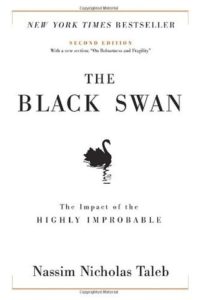October 27, 2024 Book Reviews No comments
Reflections on Productivity, Focus, and Athletic Performance: Key Takeaways from Three Books
This blog post is just my quick notes and takeaways on three books I finished listening to or reading in the last month or two. There is no other reason for these thee books to be bundled into single post other than my convinience and trying to make this relatively short.
Four thousand weeks
The book’s title itself is a reminder: we have roughly 4,000 weeks to live, a limited and precious resource. Some quick notes:
- We have only 4k weeks to live.
- Many people try to structure their lives around optimizing time and increasing efficiency, but this often leads to stress and dissatisfaction. Rather than overcommitting to work, obligations, or superficial tasks, we should focus on meaningful experiences and relationships.
- Focus on the present: Moments! Moments!
- Since time is limited, aiming for perfection is a waste of energy.
Deep Work
I’m glad I did an exercise of writing about deep work on my blog before finishing the book as it game me an opportunity to compare my thoughts before and after. I always used read/listen to books from beginning till the end; this time around I skipped first half, which explained why deep work is important and intentionally went to second part on how to achieve deep work; this is kind of stepping over myself but also because I’m convinced that deep work is key to performance. I’ve been intentionally applying what I learned from the book – this is often hard, as I need to push myself to wake early, but those 3 hours I get early in the morning are really-really super productive.
Some key learnings, recommendations from the book, not mandatorily applicable to everyone, and not in any particular order:
- Deep Work is a skill and we can improve it
- Quit social media or evaluate if it benefits you.
- Embrace boredom – this one is really funny, basically the author argues that once we have time for rest we should not fill it with distractions like scrolling on phone or watching TV, we should give our brain time to relax properly and not have habits to entertain ourselves.
- Brain focused work capacity is limited, thus we need to work on most important things early and without distractions.
- Have big blocks of focused work in the morning and for the rest of day plan each day in 30min intervals, this is not to prescribe what to work on, but to create micro deadlines.
PEAK: The new science of Athletic Performance
This is a book on athletic performance targeting sport coaches I picked from a library. I consider myself a recreational athlete (running, rock climbing, kickboxing, gym) and wanted to learn a bit of theory behing athletic performance. Some the the points below are just things I noted for myself and might be personal takeaways:
- Sleep is fundamental to both physical and mental well-being. Sleep well and enough.
- Gut Health: A diverse gut microbiome supports overall health. Strive to each veriety of foods.
- Blood Sugar and Mood: High blood sugar correlates with mood fluctuations, so stable blood sugar levels are ideal. Watch sugar consumption.
- Creatine is a safe, extensively studied supplement shown to benefit both power and endurance performance. Ok and benefitial to consume creatine.
- Optimization Choices: We can only optimize on one of the three—health, body composition, or performance. A balanced approach might be best for recreational athletes.
- Saunas: Limited impact on performance improvement. Fine to like sauna, but not really a perfomance booster.
- Recovery should be periodized to support long-term training. Rest well and enough before next trainign which should be harder (longer & intense).
- Athletic Health: Athletes fall ill more often than expected due to physical stress, though elite athletes may experience this slightly less. Listen to the body.
- Heart Rate Variability (HRV): Healthier individuals generally show slightly higher HRV. My HRV currently measures between 40-50, on the lower end for my age, likely impacted by stress. Active individuals of my age often see HRV closer to 70. Watch how this changes over time.
- Chronic Traumatic Encephalopathy (CTE): A risk associated with repetitive micro-concussions, particularly in contact sports like MMA. Take extra precautions to avoid head injuries in kickboxing.
- Mental Resilience: Elite athletes frequently employ self-talk such as “You will move up” and “You are #1” to boost performance. Experiment with positive self-talk. Maybe read book “Unf*ck youself”.
Book Review: Software Engineering at Google
July 30, 2023 Book Reviews No comments
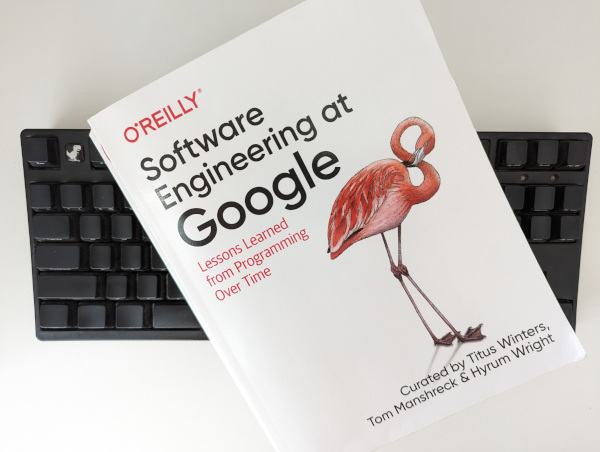
Disclaimer: I works for Google. Opinions expressed in this post are my own and do not represent opinions of my employer.
NOTE: Most of this was written in Sep 2020 (month after joining Google). I’m not too sure why I didn’t publish it back then.
I picked the book called “Software Engineering at Google” by a recommendation by one of my colleagues. Because the book is written for outsiders for me, as a Noogler, it bridges the gap between my prior external experience and knowledge and internals of Google that I start experiencing.
Some criticism? Or course. Personally I think the book is way too long for the content it contains. Style changes with each chapter. Some are written like they were someone’s life story, some are written like publications, yet some are written like promotions of a software product. I’m not telling someone did a bad job, it is just a natural outcome of multiple people writing a book.
Do I recommend the book? Yes! Though, you would gain most from reading it provided you: 1) are a software engineer AND 2) (started working at Google OR are interested in Google OR are working for another big tech company). I would say to hold reading the book till later if you have little to none industry experience and if are not working for a big software company. I think it would be hard to relate to many problems described in the book without prior experience. For example, the book would talk about source control systems and compares between distributed and centralized ones and provides an explanation why a monorepo works well at Google.
The book is not a software engineering manual, although it covers many software engineering topics. Things are mostly covered from Google’s point of view. This means that some problems might not be applicable to you and even for those problems that are applicable, solutions might not be feasible or reasonable. Most software companies hardly ever need to solve for scale of software engineers working for them, but at Google there are 10th of thousandths of SWEs, so this becomes important.
The book’s thesis is that Software Engineering extends over programming to include maintenance of software solutions.
The below is not so much book review, but rather me taking notes. Some of the below are quotes. Some of them are small comments and thoughts. Skim through it to get an idea of what’s in the book.
Thesis
- Question “What is the expected life span of your code?”
- Things change and what was efficient might no longer be.
- Scale Everything, including human time, CPU, Storage
- Hyrum’s Law: https://www.hyrumslaw.com/With a sufficient number of users of an API, it does not matter what you promise in the contract: all observable behaviors of your system will be depended on my somebody.
- Example with ordering inside of a hashmap
- “Churn Rule” – expertise scales better, this is probably why EngProd exists.
- Beyounce Rule – cover with CI what you like. For example, compiler upgrades.
- Things are cheaper at the start of a project.
- Decisions have to be made even if data is not there.
- “Jevons Paradox” – “Jevons paradox occurs when technological progress or government policy increases the efficiency with which a resource is used (reducing the amount necessary for any one use), but the rate of consumption of that resource rises due to increasing demand.” – wiki
- Time vs. scale. Small changes; no forking
- Figure with timeline of the developer workflow
- Google is data driven company, but by data we also mean, evidence, precedent, and argument.
- Leaders that admit mistakes are more respected.
Culture
- Genius is a myth. It exists because of our inherent insecurities. Many technology celebrities made there achievements by working with others. Don’t hide in your cave.
- Hiding is considered harmful (example with bike gear shifter).
- Bus factor
- Three Pillars of social interaction: humility, respect, trust.
- Techniques: rephrase critizism, fail fast and often
- Blameless
- Politicians never admit mistakes but they are on a battlefield
- Googley: thrives in ambiguity, values feedback, challenges status quo, puts the user first, cares about the team, does the right thing
Knowledge Sharing
- Challenges: lack of psychological safety, information islands, duplication, skew, and fragmentation, single point of failure, all-or-nothing, parroting (copy-paste without understanding), haunted graveyards
- Documenting knowledge scales better than one-to-many sharing by an expert, but an expert might be better at distilling all of the knowledge to particular use-case
- Psychological safety is the most important part of an effective team. Everyone should be comfortable asking questions. Personal comment: I find myself guilty of not always providing safe environment for my colleagues in the past I would use “well-actually” and frequent interuptions.
- Biggest mistake for beginners is not to ask questions immediately and continuing to struggle.
- 1-to-1 doesn’t always scale so community and chat groups can be used instead.
- To provide techtalks and classes few conditions are needed to justify them: complicated enough topic, stable, teachers needed to answer questions,
- Documentation is vital part of keeping and sharing knowledge
- “No Jerks”. Google nurchures culture of respect.
- Google provides incentives to share knowledge (for example peer bonus, kudos, etc).
- go/ links and codelabs
- Newsletters have their nieche of delivering information
- code readability process. I personally was always looking for way to make code look more uniformly throughout projects I worked on. And here we are this is implemented on the scale of entire large company. trade-off of increased short-term code-review latency for the long-term payoffs of higher quality code
Engineering for Equity
- Unconscious bias is always present and big companies have to acknowledge its presence and work towards ensuring equality.
- Google strives to build for everyone. AI based solutions are still behind and still include bias.
- It is ok to challenge existing processes to ensure greater equity.
How to Lead a Team
A really great chapter.
- Roles are Google are: The Engineering Manager (people manager), The Tech Lead (tech aspects), The Tech Lead Manager (mix)
- Technical people often avoid managerial roles as they are afraid to spend less time coding
- “Above all, resist the urge to manage” – Steve Vinter
- “Traditional managers worry about how to get things done, whereas great managers worry about things get done (and trust their team to figure out how to do it).”
- Antipaterns:
- Hire pushovers
- Ignore Low Performers
- Ignore Human Issues
- Be Everyone’s Friend (people may feel pressure to artificially reciprocate gestures of friendship).
- Compromise the Hiring Bar
- Treat your Team Like Children
- Patterns:
- Lose the Ego – gain team’s trust by apologizing when you make mistakes, not pretending to know everything, and not migromanaging.
- Be a Zen Manager – being skeptical might be something to tone down as you transition to a manager. Being calm is very important as it spreads. Ask questions.
- Be a Catalyst – build consensus.
- Remove Roadblocks – In many cases, knowing the right person can be more valuable than knowing how to solve a particular problem.
- Be a Teacher and a Mentor
- Set Clear Goals – entire team has to agree on some direction
- Be Honest – Google advises against “compliment sandwich” as it might not deliver the message. Example with analogy of stopping trains.
- Track happiness – A good way is to always ask at the end of 1:1 “What do you need?”
- Delegate, but get your hands dirty
- Don’t wait, make waves when needed
- Shield your team from chaos
- Let the team know when they do well
- People Are Like Plants – very interesting analogy
- Intrinsic vs. Extrinsic Motivation
Leading at Scale
- Three “always”: Always be Deciding, Always be Leaving, Always be Scaling
- Always Be Deciding is about trade-offs (plane story); best decision at the moment; decide and then iterate
- Always be Leaving is about not being single point of failure, avoiding bus factors
- Product is a solution to a problem. Make teams work on problems not products that can be short lived.
- The cycle of success: analysis, struggle, traction, reward ( which is a new problem)
- Important vs. Urgent – gtd, dedicated time scheduling, tracking system
- Top leaders should learn to deliberately drop some balls and conserve their energy. It is good enough to focus on 20% of things.
Measuring Engineering Productivity
- Google decided that having dedicated team of experts focusing on eng productivity is great idea. Entire research was even dedicated to study productivity.
- Case-study: readability
- Google measures using Goals/Signals/Metrics
- Signal is the way in which we will know we have achieved our goal
- Metric is exactly how we measure signals
- Actions Google takes are “tool driven” – tools have to support new things instead of just telling engineers to change anything
- For qualitative metrics consider surveys
Style Guides and Rules
- Google has style guildes which are more than just about style but more about rules
- Rules have to be: optimized for the reader of the code, have weight and not include unnecessary details, and have to be consistent.
- Example when rules can change is when this is at scale and for very long periods of time. For example, C++ rules, with an example of starting to use std::unique_ptr
Code Review
- This covers typical code review flow. Snapshots and LGTM.
- There are three aspects: any other engineer’s LGTM, owners LGTM, readability LGTM. Three can come from one person
- Code Review benefits: code correctness, code is comprehensible, consistency, ownership promotion, knowledge sharing, historical record.
- Code reviews help with validation for people who suffer from imposter syndrome.
- There is a big emphasis on writing small changes
- Write good change descriptions
- Adding more reviewers leads to diminishing returns
- Code review buckets: greenfield, behavioural changes, bug fixes, refactorings and large scale changes
Documentation
- Most documentation comes in form on code comments
- Documentation scales over time
- Arguably documentation is like code, so it should be treated like code (policies, source control, reviews, issue tracker)
- Wiki-style documentation didn’t work out because there were no clear owners, therefore documents became obsolete, duplicates appeared. This grew into number one complain.
- Documentation has to be audience oriented.
- Types of documents: reference documentation (what is code doing), design, tutorials (clear to reader), conceptual docs, landing pages (only links to other pages).
- Good document should answer: WHO (audience), WHAT (purpose), WHEN (date), WHERE (location of doc, implicit), WHY (what will it help with after reading).
- “CAP theorem” of document: Completeness, Accuracy, Clarity.
- Technical writes are helpful documenting on the boundaries between teams/APIs but are not great asset for team specific documentation.
Testing Overview
- What does it mean for a test to be small? It can be measured in two dimensions: size (can be defined by where they run: process, machine, wherever) and scope.
- Small – single process (no db, no IO, preferably single-thread); Medium – single machine, no network calls, Large – no restrictions. This can be enforced by attributing tests and frameworks that run tests.
- Scope is how much code is evaluated by a test.
- Flakiness can be avoided by multiple runs – this is trading CPU time for engineering time.
- It is discouraged to have control flows in tests (if statements, etc).
- Testing is a cultural norm at Google.
Unit Testing
- Aim for 80% UT and 20%broader tests.
- Tests have to be maintainable.
- Big emphasis on testing only via public API.
- Test behaviors and not methods.
- Jasmine is a great example of behavior driven testing.
- A little of duplication in tests is OK; not just DRY. Follow DAMP over DRY.
Test Doubles
- Seams – way to make code testable; effectively DI.
- Mocking: fake (similar to real impl); stub – specify return values; interaction testing (assert was called)
- Google’s first choice for tests is to use real implementations. Arguable this classical testing approach is more scalable.
- Fakes at Google are written and have to have tests of their own.
- It is fair to ask owners of an API to create fakes.
- Interaction testing is not preferred though warranted if no fake exists or we want to count number of calls (state won’t change).
Larger Testing
- General structure of a large test: obtain system under test (SUT), seed necessary test data, perform actions using the SUT, verify behaviors
- Larger Tests are necessary as UT cannot cover the scope of complicated interactions
- Larger tests could be of different types: performance, load, stress testing; deployment configuration testing; exploratory testing; UAT; A/B diff testing; probes and canary; disaster recovery testing; user evaluation; etc.
Deprecation
- Code is a liability, not an asset.
- Migrating to new systems is expensive. In-place refactorings and incremental deprecations can keep systems running while making it easier to deliver value to users.
- Deprecations: advisory and compulsory.
- For compulsory deprecation is it always best to have a team of experts responsible for this.
Version Control and Branch management
- Google got stuck with centralized VCS. The book argues that there really are no distributed VCS, as all of them would require a single source of truth
- I used to work with both centralized and distributed systems. What google does is even a bit more different as branching is not encouraged at all
- Sometimes it is ok to have two source of truth. For instance, Red Hat and Google can have their own versions of Linux
- Arguably if UT, IntegrationTests, CI and other policies are in place dev branches are not needed
- Other disadvantages of dev branching is difficulty of testing and isolating problems after merges
- “One Version” – for every in our repository, there must be only one version of that dependency to choose
- Hopefully in future OSS will arrive at virtual mono-repo with “One-Version” policy which will hugely simply OSS development over next 10-20 yearst
Static Analysis
- Static Analysis has to be scalable and incremental running analysis only on relevant parts
Dependency Management
- Managing dependencies is hard. Big companies come up with their unique solutions.
- A dependency is a contract so if you provide one this will cost you.
- SemVer is a standard in versioning dependencies but is only an attempt to ensure compatibility.
- Compatibility can also be ensured using test harnesses.
Large Scale Changes
- LSC might be semi-unique to Google and other super-large companies but at this scale changing int32 to int64 everywhere in code base has to have special processes in place.
Continuous Integration
- Everyone does CI these days and CI systems become ever more complex.
- Actionable feedback from CI is critical.
Continious Delivery
- “Velocity is a team sport” of reliably and incrementally delivering new value fast.
- Ways to achive this are: evaluating changes in isolation; shipping only what gets used; shifting left (more more things to earlier in the pipeline); ship early and often.
Compute as a Service
- Container based architecture adapted to a distributed and managed environment with common infrastracture is a solution to handling scale.
Book Review: Clean Architecture
September 20, 2020 Book Reviews No comments
Overall thoughts on the book

Although the book “Clean Architecture” is written by famous voice in software engineering, Robert C. Martin, and indeed has a lot of great advice it certainly did not meet my expectations. In my opinion the book is very outdated, is very focused on old ways of building software, namely monolithic and 3-layer applications for commercial enterprises. Yes there are touches on embedded software as well as on SOA and micro-services, but they seem to have been added as an afterthought. At the very least I didn’t get the feeling author had any first-hand experience with resent trends.
There were few instances were I had to stop and think for myself that I completely disagree with the author. For instance, in “The Decoupling Fallacy” chapter the author argues that services are anyway coupled because they use same data passed around and modifying interface of data requires changes in many places. Well it depends on how you design your services and example given in book looked very artificial – not something that you would see in real world implementations. Luckily it is also the point that we can redesign services to reduce this kind of coupling.
For another instance, there was an advice on introducing dedicated testing API that can bypass security and other complications to streamline testing. This seemed very odd and potentially dangerous. It might help in some places, but I would imagine this is just making things worse in the long run. Anyway my opinion.
Don’t get me wrong the book is good as a food for thought and some chapters are really great, but I don’t think it will help you design clean architecture.
Chapter by chapter
The book starts with programming paradigms, such as structured programming, object-oriented, and functional. Not sure if this fits the overall topic of the book, but the overview of these paradigms is nice and gradually takes the reader to further topics.
After these there are chapters on SOLID design principles, which I think are great. This is probably the best part of the book. I even think SOLID could have been super-short standalone book. I really appreciate the way author consolidated these principles and described in details. In many ways people can attribute these principles to him, but don’t make this mistake – they existed before and different people described them in different ways, though it is still author’s public speaking and consolidation that made them stick in heads of so many software engineers. In fact I’ve probably given tech talk on them twice in my career. In case you don’t remember SOLID stands for 5 principles: Single responsibility, Open–closed, Liskov substitution, Interface segregation, Dependency inversion.
Later author introduces the concept of components, which he defines as smallest deployable pieces of software. We can apply the same SOLID principles from code level to component level. This is where the author introduces many new definitions, which I do not think got stuck in software engineer heads. At least they didn’t get stuck in my head and I don’t remember others ever talking about them. These are things like: reuse/release equivalence principle, common closure principle, common reuse principle, etc.
After this we go one level higher where we look at boundaries between components and how we build good architecture. This is where I started taking more detailed notes. Below are some raw notes almost “as-is” when I was taking them.
Boundaries: Drawing Lines
- Non-business decisions like architecture frameworks have to be deferrable.
- What lines to draw?
- UI is independent from business rules.
- Example with business rules and database where there is a boundary between the two and database depends on business rules.
- We can make things that depend on core business rules to be plugins (GUI or Database can be considered “plugins”)
- Great example is VS and Resharper
- Breaking system into components, marking some of them as core and making others to be inject-able plugins resembles dependency injection from code level on architecture level.
Boundary Anatomy
- Boundary crossing is when function from one component calls function from another.
- Boundary strategy: local process boundaries, services, linked components. Chattiness should always be limited.
Policy and Level
- Architecture is often about building directed acyclic graph.
- “level” is distance between inputs and outputs.
Business Rules
- Business rule are rules that make or save company money.
- Entity object embodying set of business rules.
- Use-cases are descriptions for automated system. They consists of: input, output, steps in between.
- Use-cases should not describe how application looks like.
- Business rules should be the most independent and reusable code in the system.
Screaming Architecture
- Architecture should scream what this software is for and not what frameworks or algorithmic approach it is implemented with.
- Frameworks are options that are to be left open.
The clean architecture
- Good architecture: independent of UI, database, frameworks and external agency; testable.
- Dependency Rule: source code dependencies must point only inward, toward higher-level policies.
- When we pass data across a boundary it is in a form more convenient for inner circle and such that it doesn’t create a dependency on outer circle.
Presenters and humble objects
- Humble Object pattern – separation of behavior by testable and hard-to-test. This introduces us to Presenter-ViewModel-View. At least this is how it looked to me.
- Database Gateways
- Data Mappers
- Service Listeners
Partial Boundaries
- Partial boundary is when you prepare to have two components but still keep them together.
- One-dimensional boundary is similar to a Strategy pattern.
- Service boundary interface is used by clients and implemented by service. This is classic for RPCs or other communication frameworks.
- Facade – even simpler boundary
Layers and boundaries
- Gives an exampe of Hunt the Wumpus game from 1972. I wasn’t even born then! While explaining it the book mentions among other things store for the game’s persistence layer can be in cloud? Hm… weird combo.
The Main Component
- Main component – something that controls everything else. Entry point into system.
- This chapter looked like it is there to fill-in the pages.
Services: Great and Small
- Arguing that SOA and microservices are only partially allowing for decoupling, and separation of development and deployment.
- In The Decoupling Fallacy the author argues that services are anyway coupled because they use same data passed around and modifying interface of data requires changes in two places.
- Fallacy of Independent Development and Deployment. Author says that development and deployment has to be coordinated and therefore this is a lie. I somewhat disagree.
- We can do SOLID on service level and this is where I do agree.
The Test Boundary
- “From architectural point of view, all tests are the same” – hm… “Their role is to support development, not operation” – hm…
- Design for testability
- Advices to have testing API that bypass security etc.
Clean Embedded Architecture
- Getting the app to work is “app-titude test”
- Target-hardware bottleneck – what you write only works on specific hardware and can only be tested there
- For embedded software engineers the job is to firm separation between firmware and software that sit on top of hardware. HAL – hardware abstraction layer (on top of firmware).
- A clean embedded architecture should hide hardware specifics and leave them only to firmware.
- Clean embedded architecture also separates software from operating system by introducing OSAL (operating system abstraction layer).
The Database is a detail
- Arguing that hard drives will have the fate of CDs and soon everything will be stored as in RAM, via data structures.
- Tells a story or marketing for RDBMS
The Web is a detail
- Talks about osculations of moving computing power between centralized place and distributing it
- Argues that GUI is a detail.
Frameworks are details
- When you decide on a framework you make one-directional marriege commitment
Case-study: video Sales
- Split by two dimentions: Single Responsibility Principle and Dependency Rule
Conclustion
It is an ok book but somehow I don’t think I can recommend it. It won’t be waste of time, of course, but you might feel like you didn’t get much out of it – the way I feel. The nuggets that do exist in the book, like chapters on SOLID is something you can read online or even watch numerous videos with Robert C. Martin online where he talks about them.
Book Review: “Why We Sleep”
February 2, 2020 Book Reviews No comments
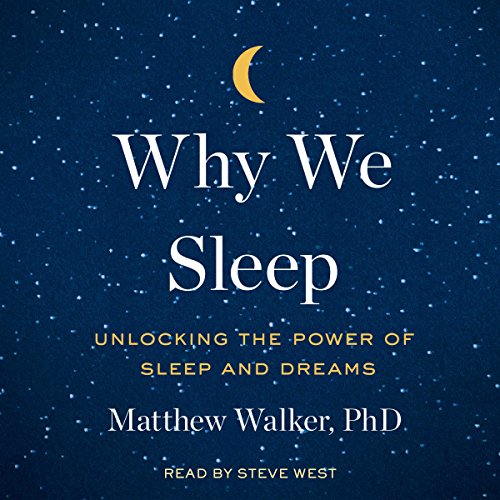
I picked the book “Why We Sleep” for listening after seeing it recommended by Bill Gates and hearing endorsement from a coworker. If you are like most of hard working people, say a software development engineer, you might think adding few extra hours of work would help in your career – it might but NOT if you steal those hours away from night’s sleep as it is simply counterproductive and all the way detrimental to your health and creativity. Read or scroll through the post to understand why sleep is important.
Importance of Sleep
The book emphasizes importance of sleep by providing numerous studies and explanations into mechanics of sleep. The book explains the impact sleep has on the quality of health, both physical and mental, as well as it explains profound effects it has on memory. In addition to all of these, not too well understood and intriguing process of dreaming is covered in great detail. I totally loved it.
If you don’t have time to read the book or this post, read these two quotes and then make your own conclusion on whether you want to to have a second thought:
…our lack of sleep is a slow form of self-euthanasia…
– Matthew Walker, Why We Sleep: Unlocking the Power of Sleep and Dreams
the shorter your sleep, the shorter your life. The leading causes of disease and death in developed nations—diseases that are crippling health-care systems, such as heart disease, obesity, dementia, diabetes, and cancer—all have recognized causal links to a lack of sleep.
– Matthew Walker, Why We Sleep: Unlocking the Power of Sleep and Dreams
Let me take you through four parts of the book:
Part 1. This thing called sleep
This chapter introduces sleep and explains benefits of sleep for the brain and memory.
Basic concepts:
- Circadian rhythm – natural sleep-wake cycle which is roughly 24h15min.
- Melatonin – natural hormone signaling darkness. Something you might want to consider when battling effects of JetLag.
- REM – Rapid Eye Movements type of sleep. This is non deep sleep when your body is still switched off, but brain is relatively active. This is also the phase when you have your dreams.
- NREM – Non REM sleep type. This is sleep type with slow brain activity.
- Sleep stages – there are 3 stages of NREM sleep with different depth and 1 stage of REM sleep in a single sleep phase.
- Sleep phase – normally people get 4 or 5 sleep phases over night with REM sleep becoming longer towards morning.
Here is how it typically looks like:
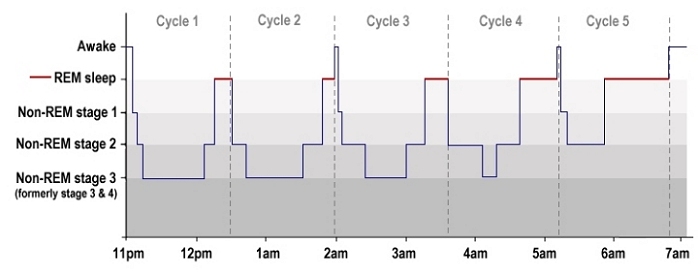
And this is how it might look for real (screenshot by a friend of mine):
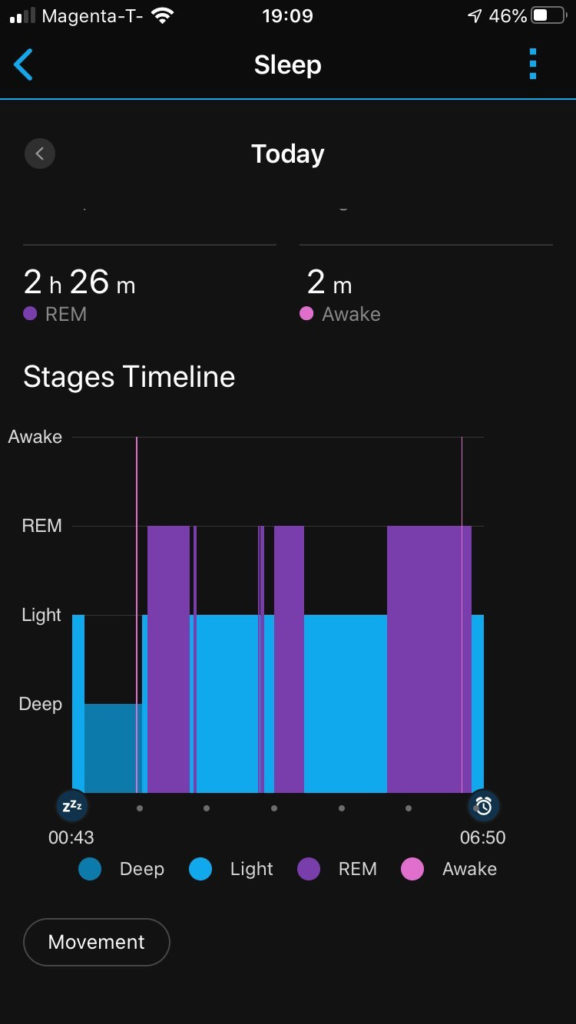
When it comes to information processing, think of the wake state principally as reception (experiencing and constantly learning the world around you), NREM sleep as reflection (storing and strengthening those raw ingredients of new facts and skills), and REM sleep as integration (interconnecting these raw ingredients with each other, with all past experiences, and, in doing so, building an ever more accurate model of how the world works, including innovative insights and problem-solving abilities).
– Matthew Walker, Why We Sleep: Unlocking the Power of Sleep and Dreams
Other chapters of this part also cover how sleep is different in some animals (half-bran sleep, partial brain sleep); how sleeping patters change with our age (deep sleep in childhood, longer sleep for adolescent, fragmented sleep in midlife and old age); sleep differences in cultures (hunter-gatherer tribes, siestas in Greece).
Part 2. Why should you sleep?
Sleep is the aid for memory. It both helps you generate new memories and store new learnings. Moreover sleep helps with creativity.
Seven hours of sleep isn’t enough; concentration depends on sleep; you cannot catch up under-slept week days with even 3 long weekend recovery nights; no proof naps can replace sleep.
Another aspect is emotional stability. Just think how much agitated your kids are when they don’t get enough sleep. Adults are the same, though we are slightly better at suppressing our display of emotions.
The book then covers some areas of human health that are affected by sleep:
- length of your life and chances of diseases (obesity, dementia, cancer, etc);
- cardiovascular system (heart diseases);
- weight gain and obesity – simply put if you are trying to loose weight and don’t sleep enough you will have hard time;
- reproductive system – sleep loss reduces hormone levels, not even talking about looking unattractive;
- immune system – if you don’t sleep enough you have nigher chances to catch an infection.
Part 3. How and why we dream
Dreaming is a self therapy. What I remember from the book is that during REM sleep we cope with our emotional state, we heal ourselves.
REM sleep is the only time during the twenty-four-hour period when your brain is completely devoid of this anxiety-triggering molecule. Noradrenaline, also known as norepinephrine, is the brain equivalent to a body chemical you already know and have felt the effects of: adrenaline (epinephrine).
– Matthew Walker, Why We Sleep: Unlocking the Power of Sleep and Dreams
As I understand it – dreaming is a combination of past lived emotions and experiences from memories semi-randomly blended together sometimes generating patches of unusual display explaining creativity.
Lucid dreaming was another interesting topic covered in the book. 20% of people can control their dreams. My wife is good at this. I sometimes can make myself fly for longer, but that’s about it.
Part 4. From sleeping pills to society transformed
This part covers various sleep-related disorders and effects modern society has on quality of sleep (screen time, caffeine, alcohol, artificial light, room temperature) as well as sleeping pills (they are bad for your health and don’t really help too much).
Sleep therapy is one of the methods that really helps with sleep. One suggestion the book gives is to “reduce anxiety-provoking thoughts and worries”. If you know how the hell this can be done, let me know!
Twelve tips for healthy sleep
I just copy-pasted these 12 tips, but I do believe they are so important it does no harm to reiterate over them.
- Stick to a sleep schedule
- Don’t exercise too late in the day
- Avoid caffeine & nicotine
- Avoid alcoholic drinks before bed
- Avoid large meals and beverages late at night
- Avoid medicines that delay or disrupt your sleep (where possible)
- Don’t nap after 3pm
- Make sure to leave time to relax before bed
- Take a hot bath before bed
- Have a dark, cool (in temperature), gadget free bedroom
- Get the right sunlight exposure
- Don’t stay in bed if you (really) can’t sleep
Conclusion
I strongly recommend reading the book especially if you are not convinced that good night’s sleep is beneficial and are choosing to work long hours.
Have a good night’s sleep next night!
Thoughts on 5 more books
January 19, 2020 Book Reviews No comments
Not too long ago I wrote a post called “It’s all in your head: thoughts on 15 books“, since then I read few more non-technical books, which I will be covering here. Technical books are usually covered in via separate blog post, like this one on Designing Data-Intensive Applications. I don’t want to turn my blog into book reviewing site, but just listing book often helps me recall some of the interesting points, so please bear with me or just skip this post :)
Can’t Hurt Me

Out of the books in this list I liked this one the most for its story. The audiobook which I listened to on audible is compilation of narration with kind of podcast insertions and comments by the author and the narrator. This really makes the book alive, like if someone was telling you a story in person. And oh my goodness… the story is something – you get to understand that some people have nightmarish lives full of suffering and yet persevere.
The book is the inspirational autobiography of David Goggins who had horrible childhood, terrible start of his adulthood, and yet despite all the odds, he has found insane drive to accomplish unthinkable, almost inhuman things, like setting world record for pull-ups, running ultramarathons, and pushing the limits of what is though possible for human body.
Some quotes:
Everything in life is a mind game! Whenever we get swept under by life’s dramas, large and small, we are forgetting that no matter how bad the pain gets, no matter how harrowing the torture, all bad things end.
Be more than motivated, be more than driven, become literally obsessed to the point where people think you’re fucking nuts.
One of the other reasons I really liked the book is that is talks a lot about running and I like running. In fact, the book and a friend of mine motivated me to run until I exhausted myself (maybe state of mind as well), unfortunately that turned out in knee joint pain and only 33km run. Hoping to complete my loop some other time.
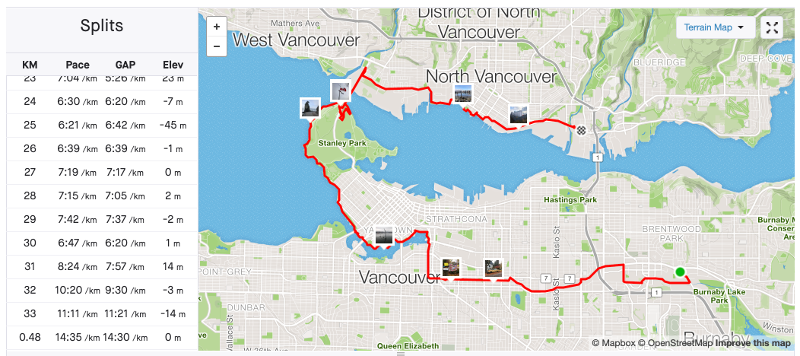
The Compound Effect

This book felt more like motivational rant by a training coach pushing you to build right habits and sticking to them. Not as foundational as “The Power of Habit” from the previous list I had, but way more inspiring. So if someone needs a little kick in the butt, this call for action book might work well. I don’t think it worked for me, though.
You will never change your life until you change something you do daily. The secret of your success is found in your daily routine.
Some of my thoughts on the compound effect
Some say, be 1% better than previous day, something like (1.01)^365 = ~37.78, which is ~3800% better, but I have a very serious reservation on this. Again on numbers: let’s say this is about workouts or running at which case gaining 1% actually hits the limits of human body. I took my best 10K number which is 54:59 (3299sec) – super slow when you compare to the world record of 26:17 (1577sec). Now let’s say I only do 1% improvement every day, or each other 3 day while training over 3 years, then I should be running 10K in 84 seconds with a speed 428km/h (900km/h for world record holder). Of course, this is ridiculous. My point here is that there are so many other things that do not fall under this rule. I bet that our mental capacities also have the limits as all of mental processing is built on top of physical brain. Again, each next 1% is exponentially harder to achieve.
David and Goliath

The other book I read earlier by Malcolm Gladwell was Outliers, which I remember as a really great eye-opener on explaining why some things stand out, therefore I was really happy to receive a recommendation to read another book by him.
The book wasn’t exactly what I expected, but I definitely found intriguing how we can look at well known historical stories from totally different perspective and how David’s approach has to be taken when you seem to be at complete disadvantage.
We all know the story of David and Goliath, but the truth is that there is nothing to be surprising about David winning the battle. Goliath is huge and cannot see, he cannot move quickly and range of his weapons are limited when David uses another approach, as put by the author:
[A] sling has a leather pouch with two long cords attached to it, and … a projectile, either a rock or a lead ball. … It’s not a child’s toy. It’s in fact an incredibly devastating weapon. … If you do the calculations on the ballistics, on the stopping power of the rock fired from David’s sling, it’s roughly equal to the stopping power of a [.45 caliber] handgun. This is an incredibly devastating weapon. … When David lines up … he has every intention and every expectation of being able to hit Goliath at his most vulnerable spot between his eyes.
So next time when you hear about the story don’t just think in terms of underdogs but also think in terms of underestimated but totally capable competitors.
Two more quotes:
You can’t concentrate on doing anything if you are thinking, “What’s gonna happen if it doesn’t go right?
The scholars who research happiness suggest that more money stops making people happier at a family income of around seventy-five thousand dollars a year. After that, what economists call “diminishing marginal returns” sets in. If your family makes seventy-five thousand and your neighbor makes a hundred thousand, that extra twenty-five thousand a year means that your neighbor can drive a nicer car and go out to eat slightly more often. But it doesn’t make your neighbor happier than you, or better equipped to do the thousands of small and large things.
Relentless

Found this one to be another motivational rant. Way-way too much about sports as for my taste. The quotes from the book, though, are quite motivational. But, again, as with any book like that – what matters is what you do afterwards. Not recommending this one.
How to Talk to Anyone

Not inspired to write a complete review here. The book, especially the first parts, is really helpful in understanding how some things could help you strike a good conversation with almost anyone, but it is too trickery for me. I anyway always spoil all of the good conversations at some point of time especially with people who are important to me. This post is a complete summary of the book (maybe 20 min read) and you are done: https://sivers.org/book/HowToTalkToAnyone Otherwise cannot recommend to read entire book.
Instead of conclusion
There is nothing to conclude here, I only ask you for recommendations of some good non-fictional books. Thank you so much for reading!
Book Review: “Designing Data-Intensive Applications”
November 24, 2019 Book Reviews, Design No comments

The book “Designing Data-Intensive Applications” is definitely one of the best technical software engineering books I’ve ever read. Also it is probably the best one you can use to prepare for system design interviews in big tech companies, so take a note. I personally made three small tech talks within my tech team based on this book and plan to maybe do few more. Engineers love this stuff.
The book is very crisp and well structured dive into architecture of under-the-hood workings of distributed data systems, such as databases, caches, queues focusing on fundamentals rather than specific implementations. The book is also based on lots of scientific research which is properly referenced so you can always go deeper into any of given topics if you would like to.
Here is the list of all of the chapters, with some of the notes, and random comments from me (not well structured, but gives a good idea on what the book is about):
- Reliable, Scalable, and Maintainable Applications
- Martin Kleppmann brings in main terminology and fundamentals in this chapter:
- Reliable – system works correctly, even when faults happen.
- Scalable – strategies for keeping performance good under load.
- Maintainable – better life for engineering and operations.
- Martin Kleppmann brings in main terminology and fundamentals in this chapter:
- Data Models and Query Languages
- Data models as in three main types of databases: document, relational, and graph, and sometimes full-text search can be considered as another data model type.
- Storage and Retrieval
- Awesome chapter where the author builds database starting with simplest possible file commands like:
- And then expanding this to log-structured databases (Bitcask, SSTables, LSM-trees, Cassandra, Lucene, etc) and to update-in-place ones, with B-trees being the main example of these and core for effectively all relational databases.
- In this chapter the author also talks about two types of categories of databases – those optimized for transaction processing and those optimized for analysis.
- Encoding and Evolution
- This chapter is looking at different types of encoding, including popular JSON, XML but also those that are language specific or those that are used to write data to disk and also all kinds of problems that come with backwards compatibility and rolling upgrades.
- Replication
- The chapter on replication explains of single-, multi-, and no- leader replication, touching of potential problems you might face with them, such as “split brain“, “seeing into the future” because of the replication lag, etc, and solutions to those problems.
- Simple example of split brain is in single-leader replication when the leader node becomes temporary unavailable and one of the replicas is elected as leader, though when the old leader comes back online it still considers itself to be the leader. These inconsistencies and situations have to be be handled in properly designed distributed systems.
- Partitioning
- Key-range partitioning – partitions based on ranges of sorted keys.
- Hash partitioning – hash function applied to each key and partitions are based on ranges of hashes.
- Local document-partitioned indexes – secondary indexes stored in the same partition. Read requires scatter/gather across all partitions, write is to single partition.
- Global term-partitioned indexes – secondary indexes partitioned as well. Read from single partition, write to many.
- Transactions
- Race conditions:
- Dirty reads – read even before data committed.
- Dirty writes – another client overrides old uncommitted data.
- Read skew – client sees different parts of database at different times. Preventable by snapshot isolation.
- Lost updates – two clients in read-modify-write overriding each others data. Preventable by snapshot isolation or manual lock.
- Write skew – premise of the write decision changed since it was read by a transaction. Preventable by serializable isolation.
- Phantom reads – transaction reads data matching search conditions that are being changed by another client. Preventable by snapshot isolation.
- Serializable transaction types: executions in serial order, two-phase locking, serializable snapshot isolation.
- Race conditions:
- The Trouble with Distributed Systems
- All kinds of crazy things can go wrong when you are dealing with distributed systems are discussed in this chapter, including lost network packets, clocks going out of sync, temp failures of nodes, heck even sharks biting underwater network cables. Here is screenshot from youtube for fun:

- Consistency and Consensus
- Achieving consensus means making all of the nodes agree on irrevocable decision. One of the ways to achieve this without implementing own consensus algorithms is to “outsource” it to tools like ZooKeeper.
- Leaderless and multi-leader systems do not require consensus, but they need to cope with such problems as conflict resolution.
- Batch Processing
- Unix tools such as awk, grep, sort have the same processing principles as MapReduce. Same concepts extrapolate into dataflow engines as well. The author shows how two main problems of partitioning and fault tolerance are solved and then goes into join algorithms for MapReduce: sort-merge joins, broadcast hash joins, partitioned hash joins.
- Batch processing jobs read some input of data and produce some output, without modifying the bounded input.
- Stream Processing
- Stream processing is different to batch processing because the input is not bounded and is never-ending, therefore sorting does not make any sense and data is served by message brokers.
- Two types of message brokers are discussed: AMQP (order not preserved, messages assigned to consumers and deleted upon acknowledgment by consumer) and log-based (order preserved and same consumer receives all messages from same partition, messages retained and can be reread).
- The Future of Data Systems
- One of the interesting approaches to designing applications is to shift amount of work done from the read path to the write path. I.e. you would do more of preprocessing when writing via materialized views and caches so that when you need to read everything is prepared for you and query is super efficient. This technique is probably something that is used often when solving scaling and latency problems.
- I especially liked the last chapter on the Future of Data Systems and section “Doing the Right Thing” entertaining on implications of intensive data usage and trying to automate things based on data. One interesting thought experiment is to replace the word data with surveillance: “In our surveillance-driven organization we collect real-time surveillance streams and store them in our surveillance warehouse. Our surveillance scientists use advanced analytics and surveillance processing in order to derive new insights.” This becomes scary, especially when we try to justify automatically made decisions without looking at ethical implications. Another interesting quote brought in this sections is this “Machine Learning is like money laundering for bias“.
Conclusion
If you are software development engineer working on scalable distributed systems is book is simply must read. Totally and absolutely recommended. I will be going through some of the chapters once or twice again as one read is not enough. Let me end with this fancy quote brought up in the book:
“The major difference between a thing that might go wrong and a thing that cannot possibly go wrong is that when a thing that cannot possibly go wrong goes wrong it usually turns out to be impossible to get at or repair.” – Douglas Adams, Mostly Harmless (1992)
It’s all in your head: thoughts on 15 books
September 22, 2019 Book Reviews, Career, Opinion, Personal 3 comments
Metacognition. Seeing with your tongue. Implanting fabricated memories. Superintelligence. Immortality. Dataism as religion. Lobsters and your social status. Number anchoring when negotiating your salary. Amoral deception. Illusion of choice and of free will.
Are you intrigued? You should be. I definitely was impressed by some of the new knowledge gained and ideas covered in few books read recently. This post is a set of short one-four paragraph book reviews. Some books I do recommend and some I don’t though still mention them for my personal record and for entertainment reasons and also to prevent you from reading them. Since this is covering 15 books the post is going to be relatively long. Please bear with me.
Learn better
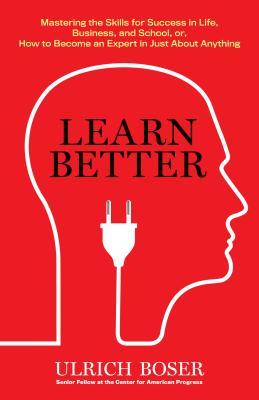
Key idea: Learning is a skill and you can teach yourself to be better in it.
The author advises 6 steps: value – make learning more valuable by associating it to things you appreciate, target – set learning goals, develop – practice with audience or teach, extend – constantly improve understanding of existing knowledge, relate – create relationship between concepts, and rethink – don’t get overconfident and dive deep to understand ever better.
Quote: “The act of writing is a good example of metacognition because when we think about composing sentences and paragraphs, we’re often asking ourselves crucial metacognitive questions: Who will be reading this? Will they understand me? What things do I need to explain? This is why writing is often such an effective way to organize one’s thoughts. It forces us to evaluate our arguments and think about ideas.”
At times I regret how I was studying at university – I could have been much more efficient had I known that the key is to retrieve the knowledge instead of repeatedly consuming information. My interpretation is that the brain works in such a way that when we consume information it is transmitted towards its storage destination igniting complex neural paths in one direction but to retrieve the information the path has to be ignited in the opposite direction as well or otherwise we risk “forgetting”. This brings us to the next book:
The Brain: The Story of You
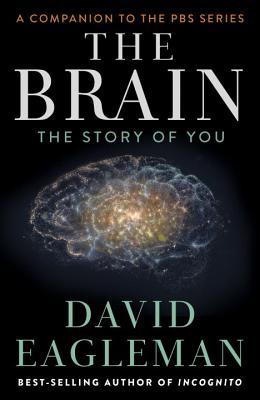
The book if full of all kinds of absolutely fascinating facts about inner workings of our brain. Sometimes even slightly creepy. For instance, read this quote below:
Quote: “So not only was it possible to implant false new memories in the brain, but people embraced and embellished them, unknowingly weaving fantasy into the fabric of their identity.”
Disregard if you believe someone can implant fake memories, this book is totally absorbing and exciting read if you are new to neuroscience and psychology and want good introduction. You would get to learn about extreme adaptive capabilities of the brain and other things. As I understand it, effectively the brain is a powerful interpretation machine taking electrical signals as input (from your ears, eyes, tongue, nostrils, skin) and translating them into flow of bioelectric processing that could cause certain chain reactions resulting in physical actions and/or secretion of chemical substances (hormones) by glands effectively making us alive. Since the brain is such a powerful interpreting machine we can work on providing it with other inputs and teaching it to handle those as well. In this way a guy has learned to see with his tongue and even climb using Brainport. This is a real product for people with disabilities consisting of a camera on outside, a pad put on tongue towards which an electric picture is projected. To extend on this, there is nothing that could prevent us from extending capacity of human body.
Or, maybe, instead we can build artificial general- or super- intelligence to help us out?
Life 3.0: Being Human in the Age of Artificial Intelligence
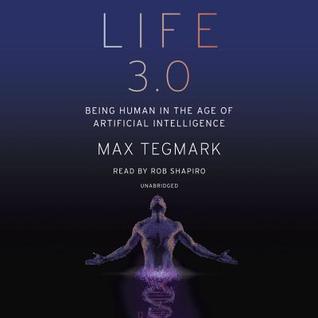
Let’s do versions first: 1.0 – biological when hardware and software evolved, 2.0 – cultural when software is designed and hardware is how it was, 3.0 – technological when both hardware and software are designed. Here “hardware” is human body and “software” is our cognitive abilities to process information.
This book reads almost as science fiction and somehow involuntarily reminds me of movies where robots and humans exist together. The book brings questions of how the society will exist when Artificial General Intelligence becomes a reality. Would we no longer need to work? Would machines try to exterminate us as in Terminator movies or harvest for energy as in The Matrix? I liked be book for bringing all of these interesting questions, entertaining on all kinds of possibilities, and exploring potential solutions to new problems we would eventually have to face and at same time not actually being a fiction.
Can we become super-humans or even gods without the help of AI? Let’s look what the next book says:
Homo Deus: A Brief History of Tomorrow

The key idea is that we eventually become god-like and gain ability to control life and environment and Homo Sapiens goes extinct. We might eventually lose our carbon-based existence and just become information.
I really like the structure of this book taking your slowly from understanding how much progress humanity has made by overcoming such horrible things as plagues, famines, and wars. Then the book sets next goals for humanity such as immortality and eternal happiness. The author then projects his historical knowledge and recent achievements in medicine and technology into what future might bring us.
We believed in gods, science, liberalism, other things. Humanism being the main “religion” of 21th century when we celebrate our own intelligence and experiences, but the final and the last one could be Dataism. You can translate everything into data! Everything. Many people measure their pulse, sleep, etc. People with diabetes wear devices that measure blood sugar levels and inject insulin as needed. People post pics on facebook, instagram nonstop, and tweet like crazy. When I run I measure speed, pace, etc and compare to earlier myself and other runners. Oh… and I write this post. Let’s go further: wondering how good sex with your partner is – easy put data sensors that measure, duration, intensity of orgasm, analyses sweat contents and put it on a plot over period of time and you know all you desire to know and, maybe, even compare to results of others. Sounds weird? I bet, but some real companies produce products like this. Now, let’s put even crazier proposition: Do you even exist if you are not connected to net and there is no digital trace of you? Right now, you would think that you do, but maybe in future ubiquitous data stream of human life becomes their life in itself?
Quote: “Senses and emotions are biochemical data-processing algorithms”
Speaking of biochemistry:
12 Rules for life

Serotonin is natural hormone associated with feeling of happiness. It is antidepressant you can get prescribed if you’ve got depression. In lobsters serotonin is regulating posture – the more serotonin – the more open lobsters posture is – the higher lobster is in its dominance hierarchy. Let’s call them alpha-lobsters (AL). Other male lobsters would know AL are tough ones and would not take on them and female ones would be attracted to AL. Female ALs would also be the ones with all the mating choices. Lobsters existed since 350M years ago (and if you recall 65M for dinos and some 200-300K for homo sapiens). Now the interesting part: the process of regulating posture and social status is embedded in humans the same way as it is in lobsters. Yeah it is very deep inside us, but, damn, crap, no! So the first rule is “Stand straight with your shoulders back”.
I didn’t like the book, though. Except of the very first rule others are not so fascinating and exciting. Not too sure what exactly to make of the first rule or what other rules are teaching us, but the book is quite popular and the author is very interesting personality (Canadian clinical psychologist with strong views), so instead of reading I would recommend to watch this first: https://www.youtube.com/watch?v=-5RCmu-HuTg (start at 3:40) and if you still want to read all 50 shades of grey in the lobster world – go ahead.
10% Happier
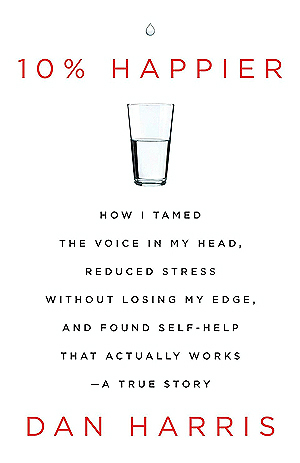
Another book I cannot really recommend. Listing here mostly for myself as not to forget. I read it and, yes, it is quite interesting as a story, but not much more. The book is like a memoir of one of the journalists who discovered his way to practicing mindfulness through his personal struggles of finding himself while building his career, reporting at war, craving for drugs (adrenalin, cocaine, whatever), and interviewing notable people, such as Dalai Lama. The only learning form this book is that celebrated people are often deceiving, they are hiding things and are driven by crazy things. The author didn’t motivate me to start meditating – I still think it is not gonna work for me. Somewhat fun read though, waste of time otherwise.
Speaking of deception:
The 48 Laws of Power
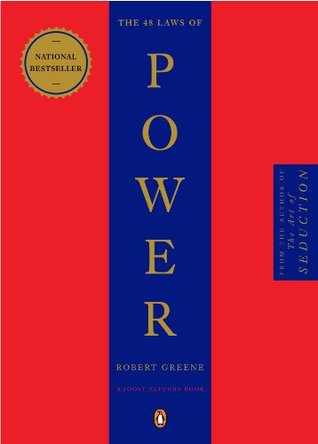
Let’s start with a disclaimer: I do NOT praise this book.
This book effectively teaches you how to deceive others and how to work your way to gain power the evil way. Wikipedia says it is a bestseller popular with prison inmates and celebrities. Description on goodread has this “This amoral, cunning, ruthless, and instructive book synthesizes the philosophies of Machiavelli, Sun Tzu, and Carl Von Clausewitz with the historical legacies of statesmen, warriors, seducers, and con men throughout the ages.”
If you want to understand how amoral this is read the quotes here: https://www.goodreads.com/author/quotes/865.Robert_Greene I don’t even want to repost them here.
Key learning: bad people exist and they could intentionally be manipulating you in psychopathic ways just to get what they want no matter what the price or method. It is good to be aware of such things and try to recognize and distinguish between people with genuinely good intentions and those who are evil. Never be a victim.
The subtle art of not Giving a F*ck

One thing that I like about this one is that the author says it is ok to not try being positive all the time. At times people are overplaying it and it is weird when they pretend to be happy. Acceptance of some of the negative experiences is a positive experience in itself.
The book is an easy and extremely entertaining read, especially if you are feeling a bit stressed and worry about too many things. Definite fun. Most of us like fun, so if you are going to read/listen to it do it mostly for that reason.
Algorithms to live by
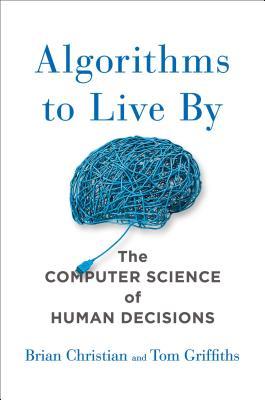
Fun book for software engineers on how you can incorporate computer algorithms into your everyday life. Just go and read. Super easy reading and wonderful way of spending your time.
Wondering how to sort your clothes and stuff in the most effective way? Like maybe sorting them by type? Nope. Wrong answer. The best way is to introduce Least Recently Used cache, making sure stuff you need the most often is always most accessible.
Go ahead and apply game theory towards making your decisions and design mechanisms for decisions instead of relying on good intentions.
Never split the difference
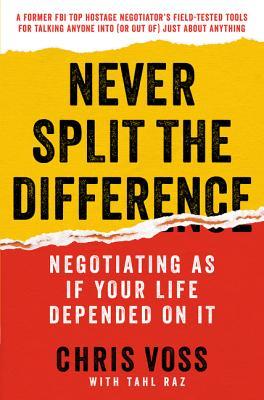
Ok, finally back to slightly more serious books, and I would go as far as to say that this book is a “must read” before your next job offer negation. The book is written by former FBI agent who worked as hostage negotiator.
It is also probably one of the most practically useful books for people who have office carriers like me and would like to apply negotiation techniques in almost any discussion. More often than not, “No” means “wait” or it means there is something the other side doesn’t want to reveal. Your job is to work through what the other side really wants.
Louder than words
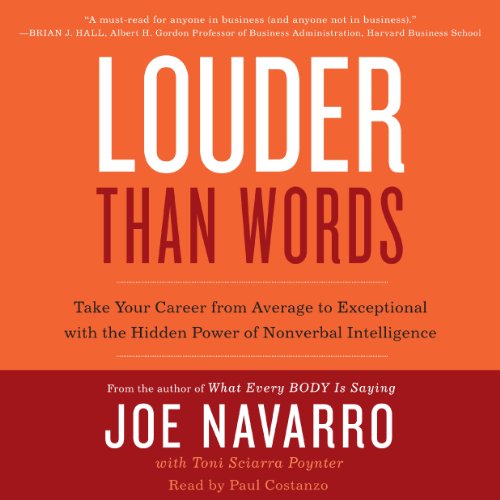
This is a book on nonverbal intelligence. I remember it being intriguing when listening to. We humans are very interested in knowing what others think. They say body language conveys 55% of communication. If this is true then we should benefit from learning to be better at understanding nonverbal messages.
Principles: Life and Work
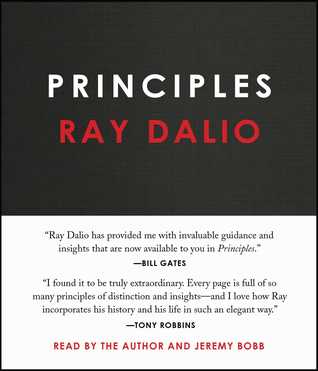
This is really good perspective on how you can structure your life and work around set of principles. I like the emphasis on always getting all the way to truth by overcoming your emotions, ego, and blind spots.
One of the great and unique notions introduced in the book is idea meritocracy that can be applied at workplace based on the following: radical truth – no filter on what you’re thinking, radical transparency – being super open for entire organization, thoughtful disagreement, believability-weighted decision making.
If you don’t have time for the book just want this great video on how economics works and then look at the principles for success videos. These two should be worth one hour of your leisure time. I really appreciate how Ray Dalio is trying to leave some legacy after him.
Extreme Ownership
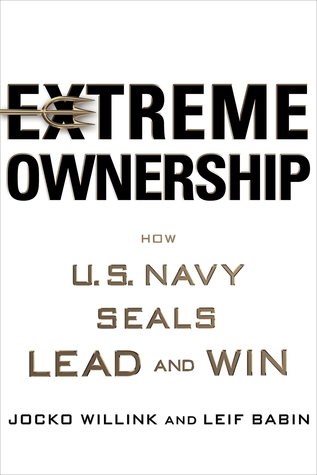
This book is written by former US Navy-Seals who fought in Iraq and in essence is partially memoir and partially book on leadership covering 12 principles towards becoming extreme owner and a real leader. The most memorable are the first and the last. The first one is extreme ownership: always take full responsibility for your own and your team’s results, never blame anyone.
Quote: “Implementing Extreme Ownership requires checking your ego and operating with a high degree of humility. Admitting mistakes, taking ownership, and developing a plan to overcome challenges are integral to any successful team.”
The last principle one is discipline equals freedom: conquer your weaknesses, procrastination since being disciplined means being fee. This brings us to another book:
The Power of Habit
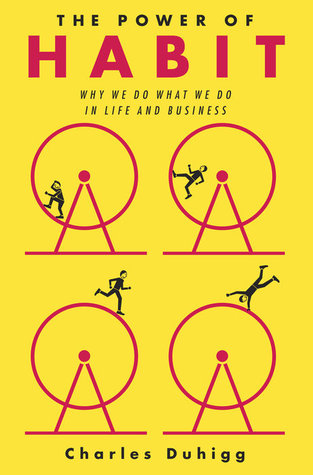
Key learning: most of our lives are structured on top of numerous habits and building right habits could propel you really far forward.
Habits have the following structure: Cue (stimuli) + Response (actions) => Reward (resulting sensations). To build a new habit you need to identify the response – which is the core of what you want to be doing, then you need to come up with cues that would repeat and eventually create craving (same timing, same location, same triggers), and then you need to make sure you get the reward or punishment. Once this is done: repeat-repeat-repeat and at one point you won’t be able to resist.
Quote: “Habits are most malleable when the Golden Rule of habit change is applied: If we keep the same cue and the same reward, a new routine can be inserted.”
Thinking Fast and Slow
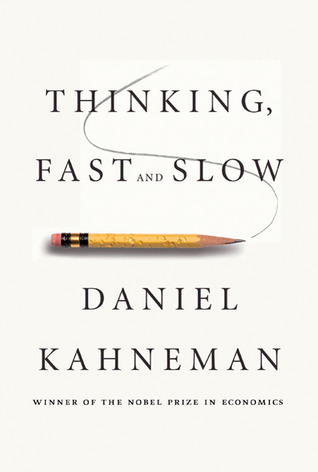
This one is written by Nobel price winner and is probably based on more research done by author himself than any other book in this list. Not an easy read. I definitely recommend the book, but probably don’t listen to it like I did. Get yourself kindle or paper version.
This is a book on how we think about things in realm of two systems: system 1 – fast processing, lazy, and emotional, automatic, and impulsive; system 2 – slow processing, rational, aware, conscious, and considerate. Although the author didn’t give these parallels I tend to think about system 1 as subconsciousness or based on subconsciousness and about system 2 as that of consciousness.
Default rule. Let me give you one example: I lived in Austria for some 6 years. Had I died in car incident I would have been donor of my organs, same is the case for 99% of drivers in Austria. Now, this number is only 12% in neighboring and culturally similar Germany. This is simply because Austria uses opt-out and Germany uses opt-in system when collecting consent. System 2 needs to put consideration in case of opt-in, while system 1 is happy to skip in case of opt-out.
Loss aversion. We are more afraid to loose something than we are eager on getting more of it. Authors provide numerous examples of loose/gain propositions with exactly same statistical outcomes and demonstrate how people choose option that sounds more safe. Unfortunately in real situations what sounds safer could be irrational and more often than not people actually make the wrong decisions. This is especially important when you make money decisions.
There are many other concepts introduced in the book all backed up by research, evaluation and phrases for remembering in the end of each chapter. Just going over all of these concepts is worth your time as it might help you make better decisions. I am considering rereading kindle version of the book after some time.
Conclusion
Personally I find this kind of books very fascinating and engaging as they provoke profound thoughts on our existence and provide guides towards enhancing our future well being.
Hopefully these short reviews are useful to you and will help you pick your next read.
Thank you.
Would be happy to receive quick recommendations on similar books in comments!
“StrengthsFinder 2.0” book and assessment
April 23, 2018 Book Reviews No comments
![StrengthsFinder 2.0 by [Rath, Tom]](https://images-na.ssl-images-amazon.com/images/I/51x%2B5b0xOiL.jpg)
The book
The book starts with arguments on why it is important to focus on your strengths versus your weaknesses. The author points out that for way too long industries are trying to “fix” people, and it has some benefits, but empowering people in areas they are best at produces significantly greater results. “We found that if your manager focuses on your strengths, your chances of being actively disengaged go down to one in one hundred. However, if your manager primarily focuses on your weaknesses, your chances of being actively disengaged are 22%, and if your manager ignores you, that percentage rises to 40%.”
“StrengthsFinder 2.0” then continues with introducing 34 different talents/strengths. The book provides brief description, a few examples of how person with this quality could sound like, and then proceeds with recommendations for individual and leader who manages person with this strength.
It makes sense to take an assessment before reading through these to know which ones to pay more attention to (though you are likely to just feel when it is about you).
The assessment
Do you know those online personality assessments where they ask you 10-20 questions and then give you a result, which says “You are 75.99% leader” or something. I am very skeptical of most of such assessment, even though, people, including me, like to take those. When I opened questionnaire that comes with the book “StrengthsFinder 2.0” I was positively surprised. It is a set of 177 questions and each of them is where you need to choose between two unrelated aspects of your personality within 20 seconds. So, from the first look, it was clear that it is superior to most of other. The book is based on 40 years of research and the assessment is taken by millions of people, so there is foundation for the assessment to be good.
Result of this assessment is 5 strengths that characterize you. You get results in a form of a document that with a description, example of how person possessing each strength would sound like, and 10 ideas for action for each strength. I was shocked by how strongly those 5 resonated with my personality, so I decided to embed few of such ideas into my own growth plan.
The assessment is available only if you buy a book (I listened to it on audiable.com) or if you purchase the access code. Link to assessment: https://www.gallupstrengthscenter.com/
My results
I keep these mostly for my own record, but what surprised me about the results was how unexpected some of those were. For instance, I never think of myself as competitive person. Though when reading through qualities of a competitive person and analyzing my own behaviour, I started to agree. This explains why I was so happy to win programming competitions, or hackathon in the past, but also why I avoid taking part in competitions where my chances are slim. Competitors don’t play to participate, they play to win.
- Competition. People who are especially talented in the Competition theme measure their progress against the performance of others. They strive to win first place and revel in contests.
- Focus. People who are especially talented in the Focus theme can take a direction, follow through, and make the corrections necessary to stay on track. They prioritize, then act.
- Achiever. People who are especially talented in the Achiever theme have a great deal of stamina and work hard. They take great satisfaction from being busy and productive.
- Analytical. People who are especially talented in the Analytical theme search for reasons and causes. They have the ability to think about all the factors that might affect a situation.
- Significance. People who are especially talented in the Significance theme want to be very important in the eyes of others. They are independent and want to be recognized.
Thoughts on the book “Mindset: The New Psychology of Success”
November 29, 2017 Book Reviews 2 comments
Just recently, using a recommendation, I read the book “Mindset: The New Psychology of Success”. In the book, Carol S. Dweck argues that people can be divided into two groups. Those who have fixed mindset and those who have growth mindset. This is how she explains it:
Believing that your qualities are carved in stone — the fixed mindset — creates an urgency to prove yourself over and over. If you have only a certain amount of intelligence, a certain personality, and a certain moral character, well then you’d better prove that you have a healthy dose of them. It simply wouldn’t do to look or feel deficient in these most basic characteristics.
A growth mindset comes from the belief that your basic qualities are things you can cultivate through effort. Yes, people differ greatly – in aptitude, talents, interests, or temperaments – but everyone can change and grow through application and experience.
Qualities of successful people and the growth mindset
Apparently the whole book argues that people with the growth mindset usually have better odds of becoming successful. Professor Dweck demonstrates this through the research she has done. Her team showed that the view people adopt of themselves has profound impact on their lives. This resonates with a famous quote by Henry Ford “Whether you think you can, or you think you can’t – you’re right”.
When I think of myself I cannot tell if I’m more of a growth mindset or of a fixed mindset. I am afraid to fail, but at the same time I am fine with trying things I could fail in. I like to prove myself, but at the same time I am open to learning and can easily admit if I don’t know something. Top grades in high school was my thing, but this didn’t stop me from taking part in math, physics, chemistry, programming competitions even I knew that at some level I will be stopped revealing that I am not that “all knowing”.
From my own observation, many successful people whom I met in life usually had an urge to prove themselves, which is explained in the book as a quality of a fixed mindset person. These people were so much afraid to fail that they put tons of effort into things they were doing. This might be one bit where I somewhat disagree with the author. Even more, it was somewhat ironical to read about desire to prove yourself as a fixed quality from a successful person who admits of being taught of fixed mindset in her childhood.
Of course, it is totally different issue when people try to prove themselves by pretending to be smarter, cooler, or whatever. I consider this to be a very bad behavior and in general a red flag for any relationship, including employer-employee.
Learning like children
In my opinion, the chapter on parenting is where the book really excels. The advice I took for myself is not to praise my children for how smart they are, but instead praise them for their effort. I strongly agree that it is important to develop children’s desire to learn things, to encourage their curiosity, and to work on their resilience to failure. It has been for couple of weeks as I try to use this advise with my daughter and it really works. My toddler daughter now seeks to put more effort into little things she does.
We all should be more like little children when it comes to learning and trying new things. A baby doesn’t question its ability to learn how to walk. Small failure is nothing more than a learning experience. While I was writing this blog post I also stumbled upon another idea that when we are young we are full of curiosity and intrinsic motivation but overtime it is replaced by extrinsic motivation in form of grades, ratings, incentive pay, etc. I think this idea by Edwards Deming plays very well with the ideas in the “Mindset” book, especially considering that Carol S. Dweck has done a lot of her research on students and children.
I want to leave you with this great illustration of the two mindsets.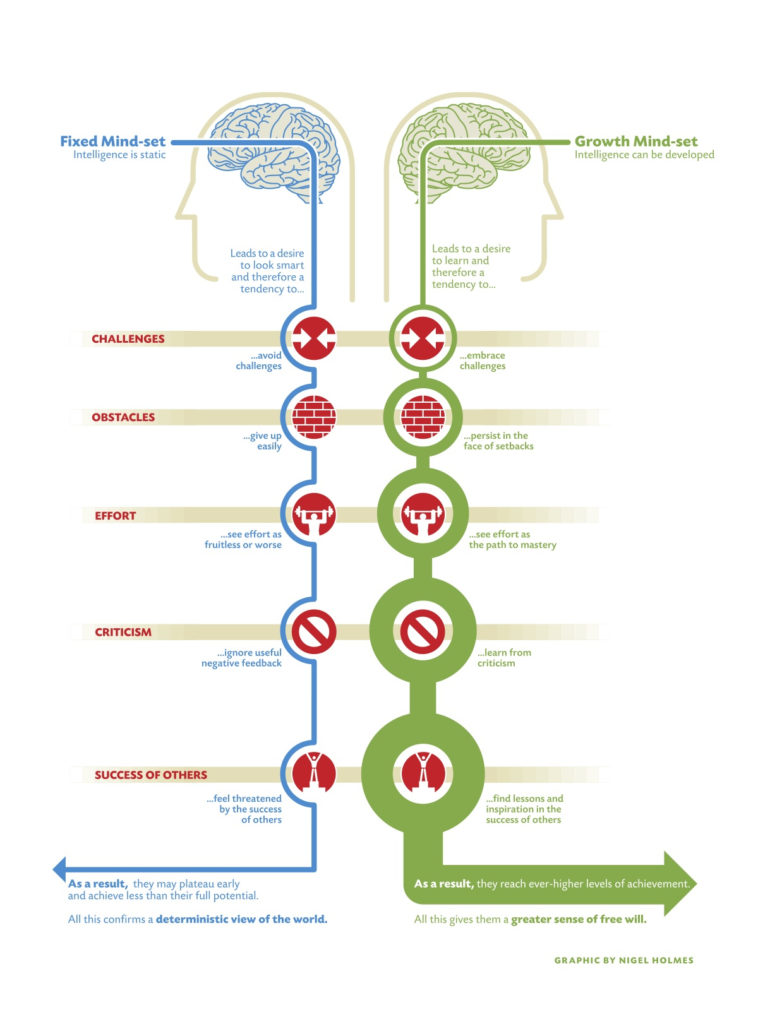
Book Review: “The Black Swan”
October 30, 2016 Book Reviews No comments
A black swan is a highly improbable event with three principal characteristics: It is unpredictable; it carries a massive impact; and, after the fact, we concoct an explanation that makes it appear less random, and more predictable, than it was. The astonishing success of Google was a black swan; so was 9/11. For Nassim Nicholas Taleb, black swans underlie almost everything about our world, from the rise of religions to events in our own personal lives.
I have listened to the audio version of “The Black Swan” twice. First time at the beginning of the year and the second time just recently. The book is philosophical in a way. It is not very easy to fully comprehend conveyed message as author frequently diverts to fictional stories, terms in French, and thinkers that are long time dead.
There were two striking statements in the book “anyone can be a president” if someone like “these people can get a Nobel prize”. Sounds actual? Think of Trump vs. Clinton presidential race and Bob Dylan receiving Nobel prize in Literature if you are not reading this in Autumn 2016.
This does not mean that Nassim Taleb is any sort of predictor or prophesy maker. He himself says that he cannot make predictions, instead he highlights over and over again that rare events that seem improbable do occur more frequently than most of us would imagine and at the same time it is impossible to come up with mathematical models that would somehow calculate probabilities for these events. Unfortunately, we cannot know what we don’t know, therefore the best strategy for any of us is to build robustness to black swan events.
Application of the ideas expressed in the book is very wide. Starting with building financial portfolio consisting of 90% of very safe investments and 10% of extremely risky ones, therefore exposing yourself to probability of catching a black swan, like Google or Facebook. Ending with applying it to your life by exposing yourself to variety of endeavors. Careful here: event’s consequences are even harder to predict than occurrence of such events.
There is one aspect of the book that I don’t like. The author almost throughout the book despises other people imagining them as aggressive apes and suggesting nasty things like putting a rat down someones shirt. I do not exclude that he imagines his readers in the same way: silly monkeys reading higher caliber philosophical work. This, though, does not disqualify his book from being a really valuable contribution to human knowledge, but, in my opinion, it is only thanks to the black swan event of him benefiting from the 2000 crisis that made him successful and subsequently allowed him to write this and other books.
Conclusion
This book is definitely worth reading. It may make you look at the world as sequences of improbable events that change everything around. It could also make you way more skeptical about the theoretical modeling suggested by economists and other tie wearing experts. The book is not an easy read. On the contrary, it requires a lot of attention and thinking. Maybe leave it for a time when you are in a “philosophical” mood.

